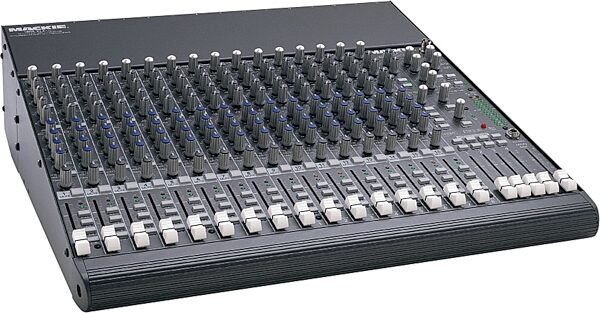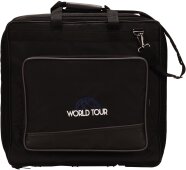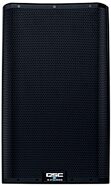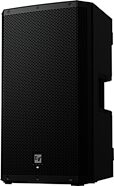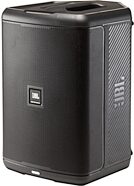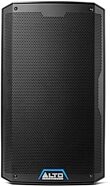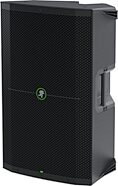
Mackie 1604VLZ4 16-Channel Mixer
With 16 Onyx mic preamps, 4 subgroups and 4 auxes, the 1604 VLZ4 has the I/O you need to run the show, with Mackie's legendary high headroom and low noise.
$1,049.99
- 18 x
- 12 x$87.50
- 8 x$131.25
- No Credit Check6 x$175.00
- No Credit Check4 x$262.50
Mackie 1604-VLZ Pro 16-Channel Mixer
No longer available at zZounds



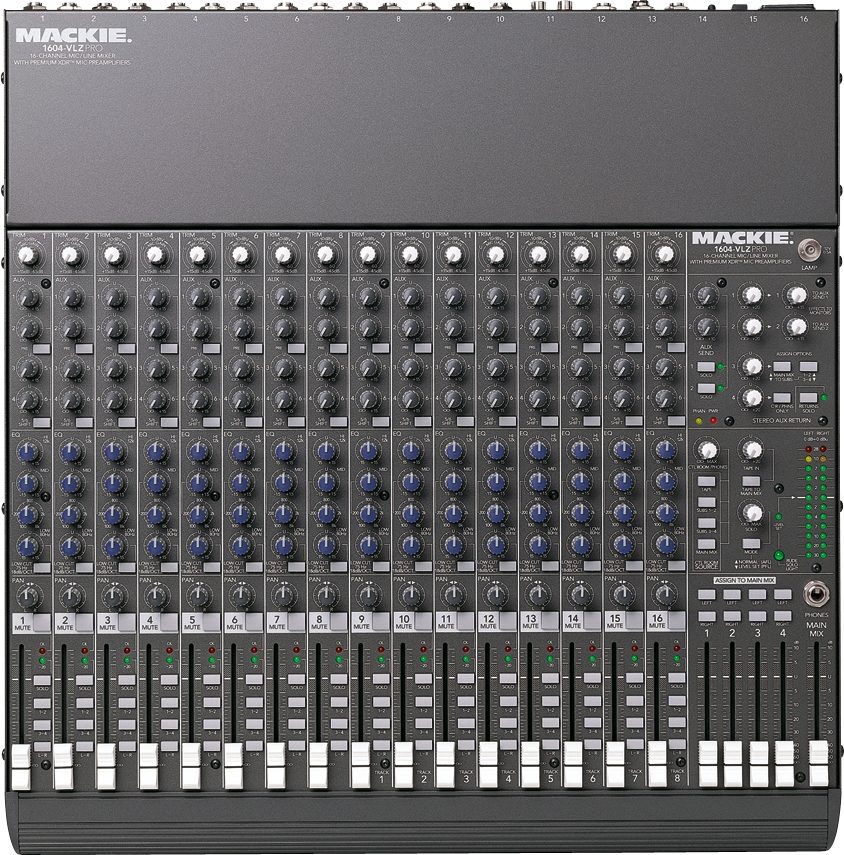
zZounds Gear Experts Say...
16x4 professional compact mixer.
Overview
No matter how much you spend on a microphone, its ultimate performance depends on how it interacts with the preamp it's plugged into. Many high-end mic preamps can effortlessly amplify the slightest sonic nuance, creating an aural panorama that's breathtakingly realistic, excitingly vivid, and truly 3-dimensional in scope. For years they've provided fidelity that just hasn't been possible with the "stock" mic preamps built into mixing consoles. Until now.
To develop the new XDR (eXtended Dynamic Range) mic preamp, the engineering team started with blank paper, concerned only with matching or exceeding the performance of $500 to $2000-per-channel esoteric preamps. They went through hundreds of iterations and revs and spent countless hours subjectively listening (and arguing). They started all over again several times. They scoured the world for rare parts. Then they spent more time critically listening and evaluating the design with every high-end microphone you can think of. Then they brought in veteran recording and live sound engineers for more exhaustive listening tests.
What they ultimately ended up with is not just an awesome sounding design. XDR is also a) highly resistant to damage caused by "hot patching" (caused by routing a phantom powered mic through a patch bay); b) remarkably independent of cable-induced impedance variations; and c) able to reject extremely high RF levels without compromising high frequency response.
Because a mic preamp must amplify faint one… read more millivolt input signals up to a thousand-fold (60dB), its rectification components can also pick up radio frequency interference (RFI) from AM and FM stations, cell phones, and pager transmitters - even microwave ovens - and amplify them to audible levels.
Mackie assaulted RFI on 3 fronts. First, they incorporate bifilar wound DC pulse transformers with high permeability cores that reject RFI but don't attenuate the sound at 15kHz and above. Second, they use carefully matched, high-precision components for critical areas of the XDR preamplifier. Third, they direct-coupled the circuit from input to output and used pole-zero cancellation constant current biasing (which also avoids increased intermodulation distortion at high common mode signal levels).
Bottom line for the non-technical: you can use the new XDR mic preamps at the end of extremely-long cheap mic cables in an RFI-saturated urban environment while talking on your cell phone...without hearing a trace of RFI.
If a mic preamp isn't designed right, it will actually sound different depending on the impedance of the microphone and the cable load! XDR's Controlled Interface Input Impedance system accepts an enormous range of impedances without compromising frequency response.
0.0007% Total Harmonic Distortion. The lowest ever in any compact mixer.
Flat response. Not only are XDR mic preamps flat within a tenth of a dB across the bandwidth of any known microphone, but are also only 3dB down at an astonishing 192kHz!
Super-low intermodulation distortion at very high operating levels thanks to instrumentation-style balanced differential architecture, linear biasing, and use of DC-coupled pole-zero-cancellation constant current that frees the mic preamp from power supply fluctuations.
Think of the 1604 as an ultra-premium, esoteric mic preamp... that just happen to have really excellent compact mixers attached.
Features
Ultra-low noise, highest headroom in its class
16 new precision-engineered XDR Extended Dynamic Range premium studio-grade mic preamps with: Ultra-wide 0-60dB gain range, 130dB dynamic range for 24-bit, 192kHz sampling rate inputs, +22dBu line input handling, distortion under 0.0007% (20Hz-20kHz)
Advanced DC pulse transformer RF rejection
4 subgroups with left and right assigns and direct outs
16 line inputs, 16 channel inserts
60mm long-wearing logarithmic-taper faders
Constant-loudness pan controls
Switchable AFL/PFL Solo
6 aux sends per channel with 15dB gain above Unity
Aux 1 and 2 pre/post
Aux Send 1-2 Master section with level controls, Solo switches, and Solo LEDs
Level, pan; -20, Solo and OL LEDs on each channel
RUDE solo light doubles as a mini-tanning booth
4 stereo aux returns, 8 direct outs
3-band active EQ with sweepable midrange
18dB/oct. 75Hz Lo Cut filter on each channel
Control Room/Phones outputs with multi-input source matrix
RCA tape inputs and outputs
Tape input level control and Tape To Main Mix switch
Balanced 1/4 in. inputs and outputs (except inserts)
Switchable phantom power for condenser mics
5 physical configurations via rotating I/O pod
Rugged steel main chassis, sealed rotary controls
Built-in power supply, rack mount kit included read less
To develop the new XDR (eXtended Dynamic Range) mic preamp, the engineering team started with blank paper, concerned only with matching or exceeding the performance of $500 to $2000-per-channel esoteric preamps. They went through hundreds of iterations and revs and spent countless hours subjectively listening (and arguing). They started all over again several times. They scoured the world for rare parts. Then they spent more time critically listening and evaluating the design with every high-end microphone you can think of. Then they brought in veteran recording and live sound engineers for more exhaustive listening tests.
What they ultimately ended up with is not just an awesome sounding design. XDR is also a) highly resistant to damage caused by "hot patching" (caused by routing a phantom powered mic through a patch bay); b) remarkably independent of cable-induced impedance variations; and c) able to reject extremely high RF levels without compromising high frequency response.
Because a mic preamp must amplify faint one… read more millivolt input signals up to a thousand-fold (60dB), its rectification components can also pick up radio frequency interference (RFI) from AM and FM stations, cell phones, and pager transmitters - even microwave ovens - and amplify them to audible levels.
Mackie assaulted RFI on 3 fronts. First, they incorporate bifilar wound DC pulse transformers with high permeability cores that reject RFI but don't attenuate the sound at 15kHz and above. Second, they use carefully matched, high-precision components for critical areas of the XDR preamplifier. Third, they direct-coupled the circuit from input to output and used pole-zero cancellation constant current biasing (which also avoids increased intermodulation distortion at high common mode signal levels).
Bottom line for the non-technical: you can use the new XDR mic preamps at the end of extremely-long cheap mic cables in an RFI-saturated urban environment while talking on your cell phone...without hearing a trace of RFI.
If a mic preamp isn't designed right, it will actually sound different depending on the impedance of the microphone and the cable load! XDR's Controlled Interface Input Impedance system accepts an enormous range of impedances without compromising frequency response.
0.0007% Total Harmonic Distortion. The lowest ever in any compact mixer.
Flat response. Not only are XDR mic preamps flat within a tenth of a dB across the bandwidth of any known microphone, but are also only 3dB down at an astonishing 192kHz!
Super-low intermodulation distortion at very high operating levels thanks to instrumentation-style balanced differential architecture, linear biasing, and use of DC-coupled pole-zero-cancellation constant current that frees the mic preamp from power supply fluctuations.
Think of the 1604 as an ultra-premium, esoteric mic preamp... that just happen to have really excellent compact mixers attached.
Features
Ultra-low noise, highest headroom in its class
16 new precision-engineered XDR Extended Dynamic Range premium studio-grade mic preamps with: Ultra-wide 0-60dB gain range, 130dB dynamic range for 24-bit, 192kHz sampling rate inputs, +22dBu line input handling, distortion under 0.0007% (20Hz-20kHz)
Advanced DC pulse transformer RF rejection
4 subgroups with left and right assigns and direct outs
16 line inputs, 16 channel inserts
60mm long-wearing logarithmic-taper faders
Constant-loudness pan controls
Switchable AFL/PFL Solo
6 aux sends per channel with 15dB gain above Unity
Aux 1 and 2 pre/post
Aux Send 1-2 Master section with level controls, Solo switches, and Solo LEDs
Level, pan; -20, Solo and OL LEDs on each channel
RUDE solo light doubles as a mini-tanning booth
4 stereo aux returns, 8 direct outs
3-band active EQ with sweepable midrange
18dB/oct. 75Hz Lo Cut filter on each channel
Control Room/Phones outputs with multi-input source matrix
RCA tape inputs and outputs
Tape input level control and Tape To Main Mix switch
Balanced 1/4 in. inputs and outputs (except inserts)
Switchable phantom power for condenser mics
5 physical configurations via rotating I/O pod
Rugged steel main chassis, sealed rotary controls
Built-in power supply, rack mount kit included read less
Specs
Main Mix Noise
20Hz-20kHz bandwidth, 1/4 in. Main Out, channel Trims @ unity gain, channel EQs flat, all channels assigned to Main Mix, odd channels panned left, even channels panned right
Main Mix faders down, channel faders down: -100dBu
Main Mix fader unity, channel faders down: (90dB Signal to Noise Ratio, ref +4dBu) -86.5dBu
Main Mix fader @ unity, channel faders @ unity: -84.0dBu
Total Harmonic Distortion (THD)
1kHz @ +14dBu: 20Hz-20kHz
Mic in to Main out: below 0.0007%
Attenuation (Crosstalk)
1kHz relative to 0dBu, 20Hz-20kHz bandwidth, Line in, 1/4" Main Out, Trim @ unity
Channel Mute switch engaged: -84dBu
Channel fader down: -84dBu
Frequency Response
Mic input to any output
20Hz to 60kHz: +0dB/-1dB
10Hz to 100kHz: +0dB/-3dB
Equivalent Input Noise (EIN)
Mic in to insert Send out, max gain
150 ohm termination: -129.5dBm unweighted
Common Mode Rejection (CMR)
Mic in to insert Send out, max gain
1kHz: better than 90dB
Maximum Levels
Mic In: +22dBu
All other inputs: +22dBu
Main Mix 1/4 in. TRS outputs: +28dBu
All other outputs: +22dBu
Impedances
Mic In: 1.3 kilohms
Channel Insert return: 2.5 kilohms
All other inputs: 10 kilohms or greater
Tape out: 1.1 kilohms
All other outputs: 120 ohms
EQ
High Shelving:
20Hz-20kHz bandwidth, 1/4 in. Main Out, channel Trims @ unity gain, channel EQs flat, all channels assigned to Main Mix, odd channels panned left, even channels panned right
Main Mix faders down, channel faders down: -100dBu
Main Mix fader unity, channel faders down: (90dB Signal to Noise Ratio, ref +4dBu) -86.5dBu
Main Mix fader @ unity, channel faders @ unity: -84.0dBu
Total Harmonic Distortion (THD)
1kHz @ +14dBu: 20Hz-20kHz
Mic in to Main out: below 0.0007%
Attenuation (Crosstalk)
1kHz relative to 0dBu, 20Hz-20kHz bandwidth, Line in, 1/4" Main Out, Trim @ unity
Channel Mute switch engaged: -84dBu
Channel fader down: -84dBu
Frequency Response
Mic input to any output
20Hz to 60kHz: +0dB/-1dB
10Hz to 100kHz: +0dB/-3dB
Equivalent Input Noise (EIN)
Mic in to insert Send out, max gain
150 ohm termination: -129.5dBm unweighted
Common Mode Rejection (CMR)
Mic in to insert Send out, max gain
1kHz: better than 90dB
Maximum Levels
Mic In: +22dBu
All other inputs: +22dBu
Main Mix 1/4 in. TRS outputs: +28dBu
All other outputs: +22dBu
Impedances
Mic In: 1.3 kilohms
Channel Insert return: 2.5 kilohms
All other inputs: 10 kilohms or greater
Tape out: 1.1 kilohms
All other outputs: 120 ohms
EQ
High Shelving:
Documents and Manuals
For support or warranty questions, please contact the manufacturer:
Phone: 800-898-3211
Email: support@mackie.com
Web: https://mackie.com/en/support/contact
Phone: 800-898-3211
Email: support@mackie.com
Web: https://mackie.com/en/support/contact
Reviews
Reviewers gave this product an overall rating of 5 out of 5 stars.
(155 ratings)
Submitted November 12, 2006 by a customer from hotmail.com
"If you do small concerts and hall shows, LOOK HERE!!!"
This review has been selected by our experts as particularly helpful.
If your going to be doing small small concernts and hall shows, this mixer is perfect for you. 16 Channels will start limiting you if you get into too big of a concernt but for hall shows, nothing compares to it. I only used mine for hall shows and recording, and I never ran out of channels or good quality. Its tough, its good and its got a competative price tag
Sound
I love this frickin thing. I used to do a tonne of hall shows and small concerts. Honestly, I never had any problems with it, the mix is great and once you learn the board, it is just as powerfull as Mackies high end mixer. The clip head is great, the sound is great, its just a really sweet mixer if your going to be doing small concerts and hall shows.
Features
Standard 3 band EQ with sweepable low frequency rangs, low range cut, amazing aux in out abbility for a small board.
Ease of Use
Like any mixing board, you get used to it and its still a little trouble getting around quickly when you need to. It does take a little while to learn how it likes to work, it can be touchy at times but once you figgure it out your golden.
Quality
Well lets put it this way, you can stand on it, you can jump on it, you can drop it (caseless!) and you can smack it when you get angry because your mix aint working and she keeps workin. I never had any problems with its durability, its made to last the extreems… read more of long road trips and those days your too tired to care how you handle your gear. If your just using it local itl live longer than you will!
Value
Its pricy, but you get what you pay for, and in this case your getting a lot for what you paid for. There are a few little things that would be nice if it had but are simplie 5 dollar external fixes. In comparison to other equipment out there at the same or twice the price, it blows it away.
Manufacturer Support
Mackie not only makes the best products but have an excellent customer support department. If you have technical questions, how to use questions, anything, you get someone who knows what their talking about and will help you until your problem is fixed. No general answers or standard response steps. Each problem is analised on an individual basis to give you the most informative answer.
The Wow Factor
To a seasoned pro who works concerts all the time, hell look at the board and say "yeah thats a pretty good board." Its a 16 channel mixer, its not exactly desirable by any large company but to who do hall shows often, thel see this thing, try it and get addicted. Those who dont do it often find the board too confusing and hate it but I find with anyone who knew what they were doing, they wanted to steal it from me!
Musical Background:
Sound Technician, drummer, newb bassist :P
Musical Style:
Rock and punk read less
Sound
I love this frickin thing. I used to do a tonne of hall shows and small concerts. Honestly, I never had any problems with it, the mix is great and once you learn the board, it is just as powerfull as Mackies high end mixer. The clip head is great, the sound is great, its just a really sweet mixer if your going to be doing small concerts and hall shows.
Features
Standard 3 band EQ with sweepable low frequency rangs, low range cut, amazing aux in out abbility for a small board.
Ease of Use
Like any mixing board, you get used to it and its still a little trouble getting around quickly when you need to. It does take a little while to learn how it likes to work, it can be touchy at times but once you figgure it out your golden.
Quality
Well lets put it this way, you can stand on it, you can jump on it, you can drop it (caseless!) and you can smack it when you get angry because your mix aint working and she keeps workin. I never had any problems with its durability, its made to last the extreems… read more of long road trips and those days your too tired to care how you handle your gear. If your just using it local itl live longer than you will!
Value
Its pricy, but you get what you pay for, and in this case your getting a lot for what you paid for. There are a few little things that would be nice if it had but are simplie 5 dollar external fixes. In comparison to other equipment out there at the same or twice the price, it blows it away.
Manufacturer Support
Mackie not only makes the best products but have an excellent customer support department. If you have technical questions, how to use questions, anything, you get someone who knows what their talking about and will help you until your problem is fixed. No general answers or standard response steps. Each problem is analised on an individual basis to give you the most informative answer.
The Wow Factor
To a seasoned pro who works concerts all the time, hell look at the board and say "yeah thats a pretty good board." Its a 16 channel mixer, its not exactly desirable by any large company but to who do hall shows often, thel see this thing, try it and get addicted. Those who dont do it often find the board too confusing and hate it but I find with anyone who knew what they were doing, they wanted to steal it from me!
Musical Background:
Sound Technician, drummer, newb bassist :P
Musical Style:
Rock and punk read less
27 of 30 people (90%) people found this review helpful. Did you?
Thanks for your opinion!
No longer available at zZounds
This is a carousel with product cards. Use the previous and next buttons to navigate.
